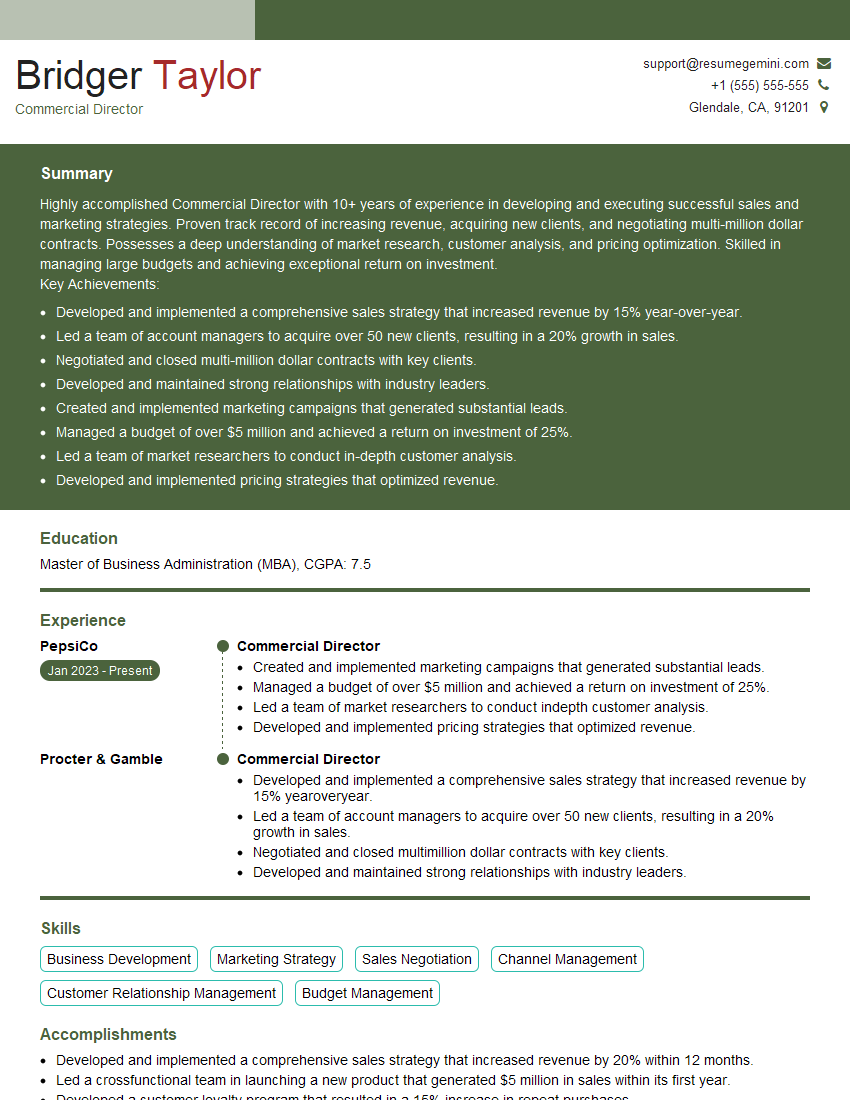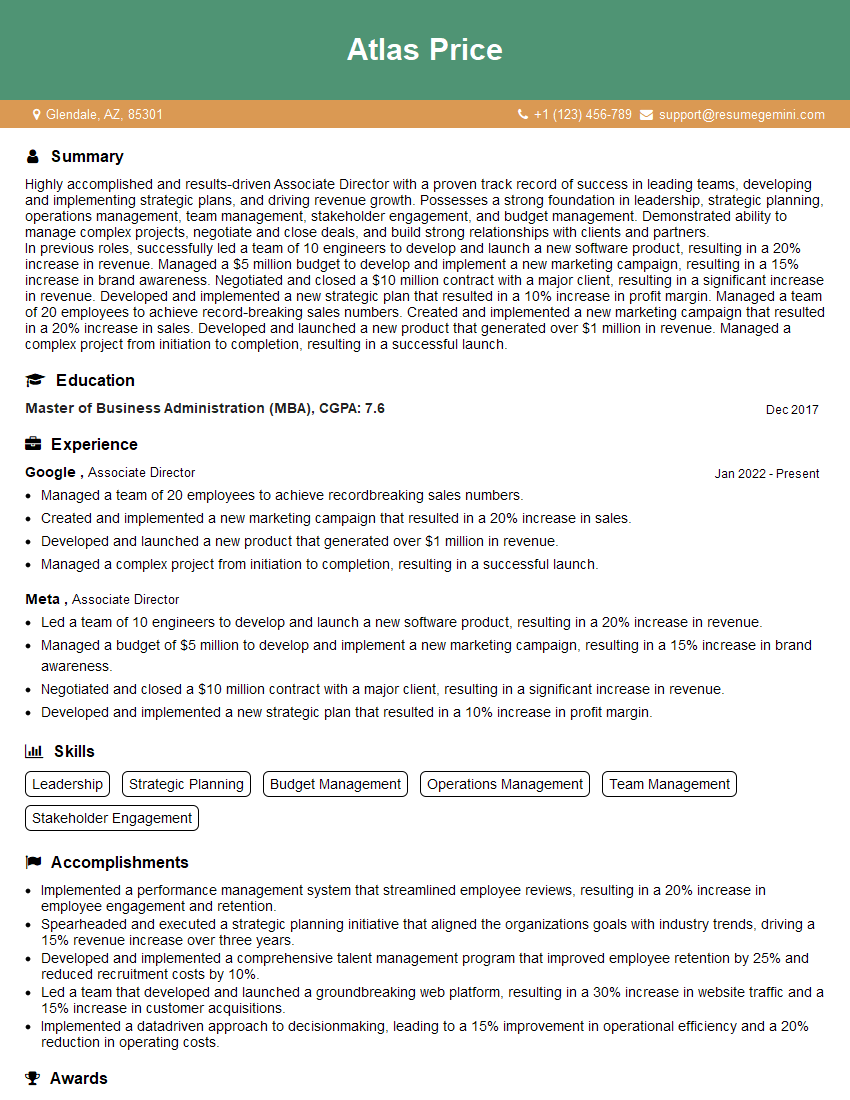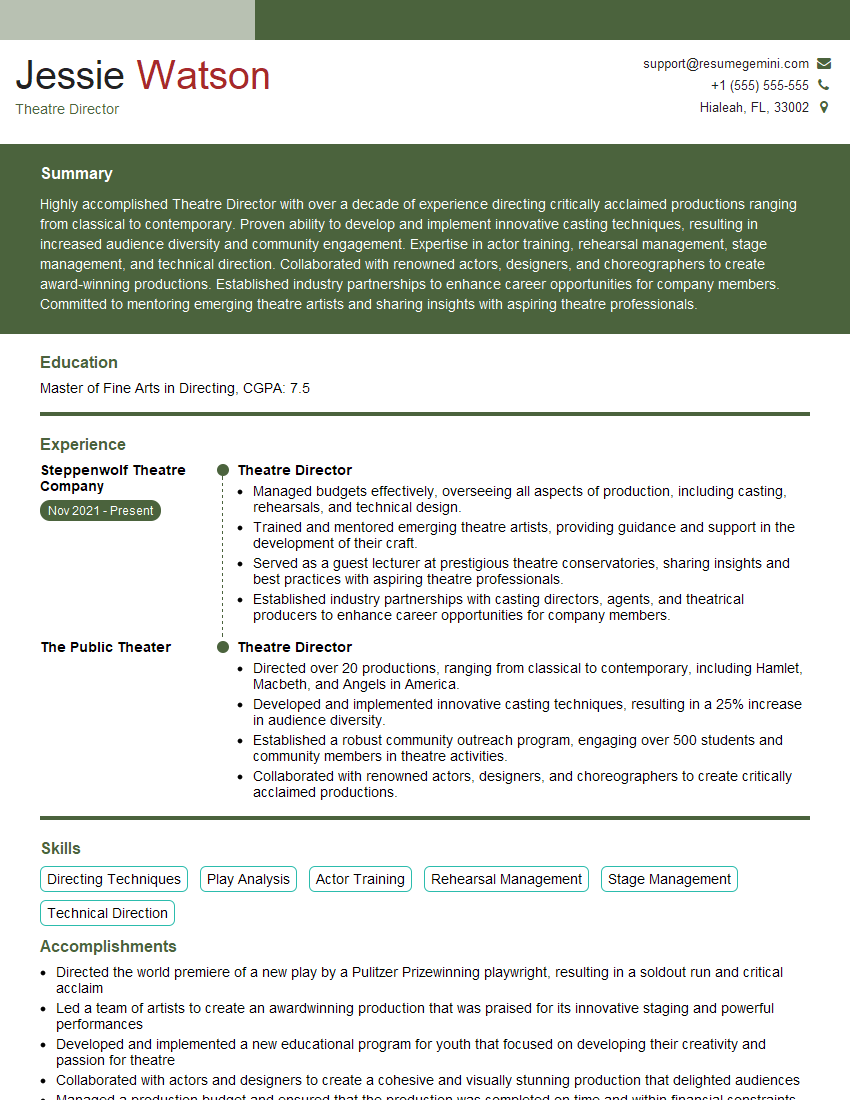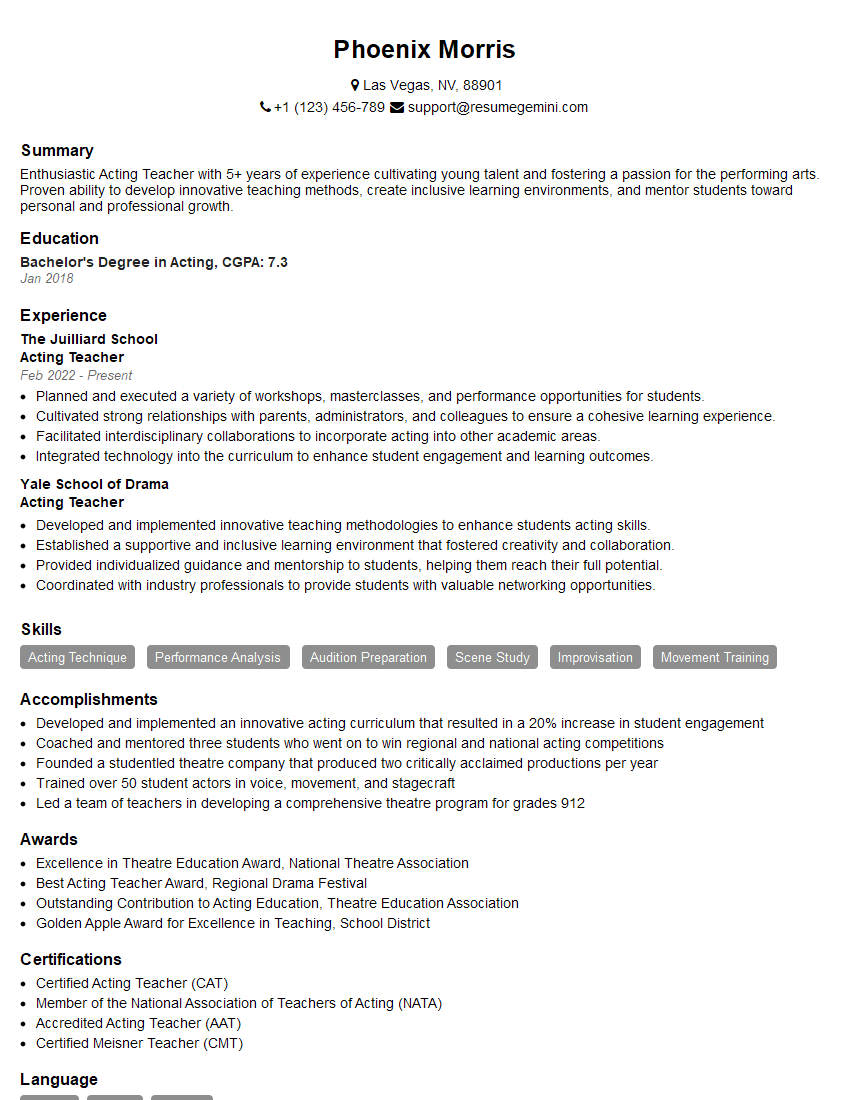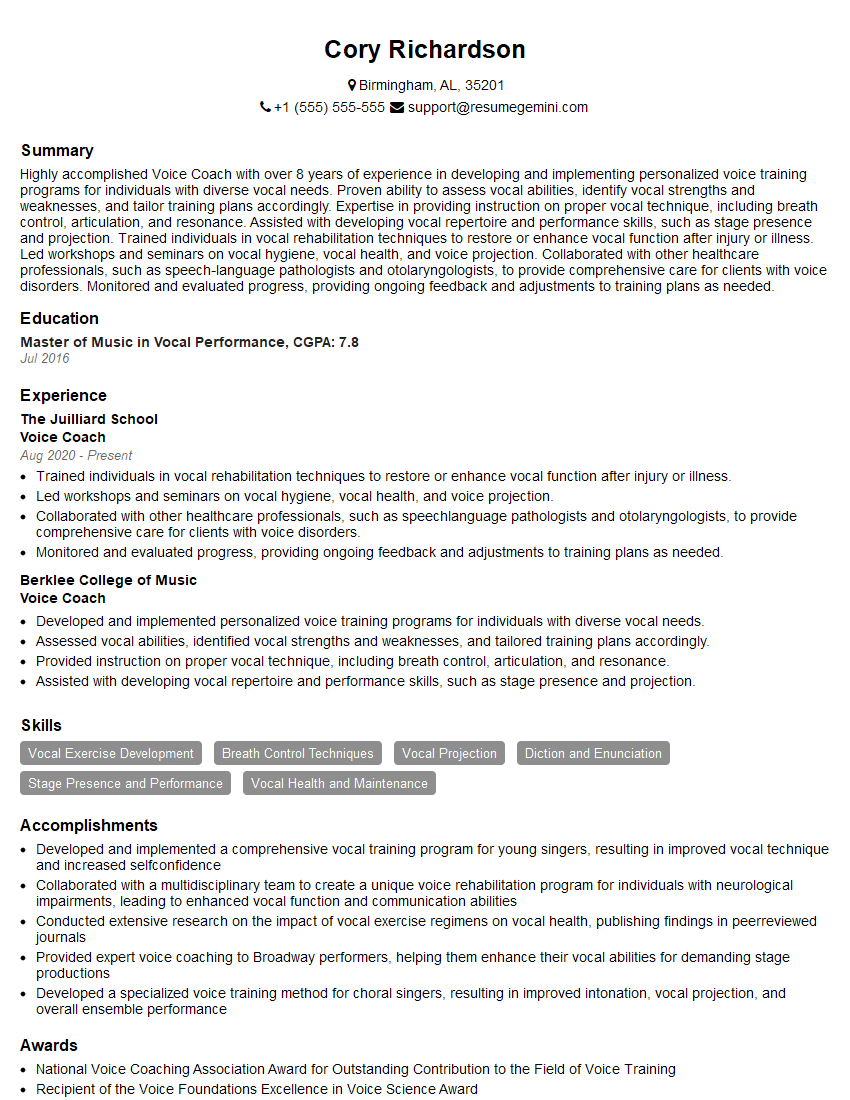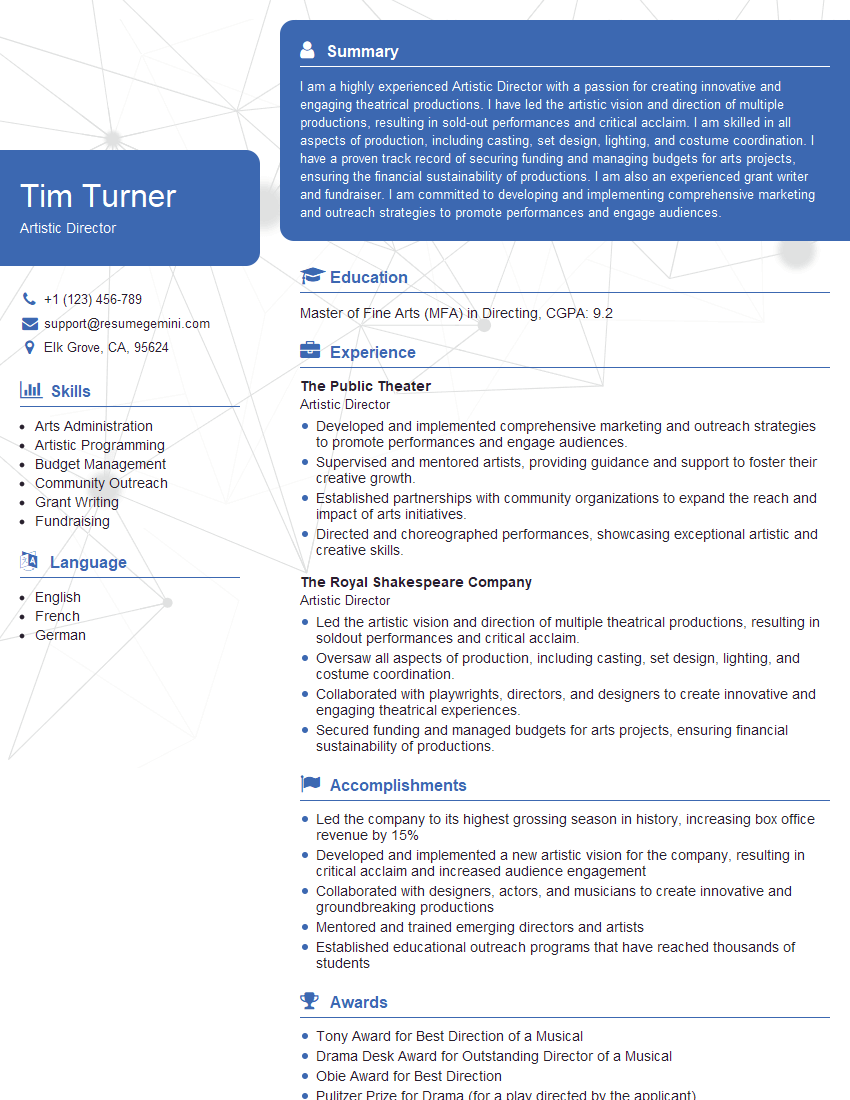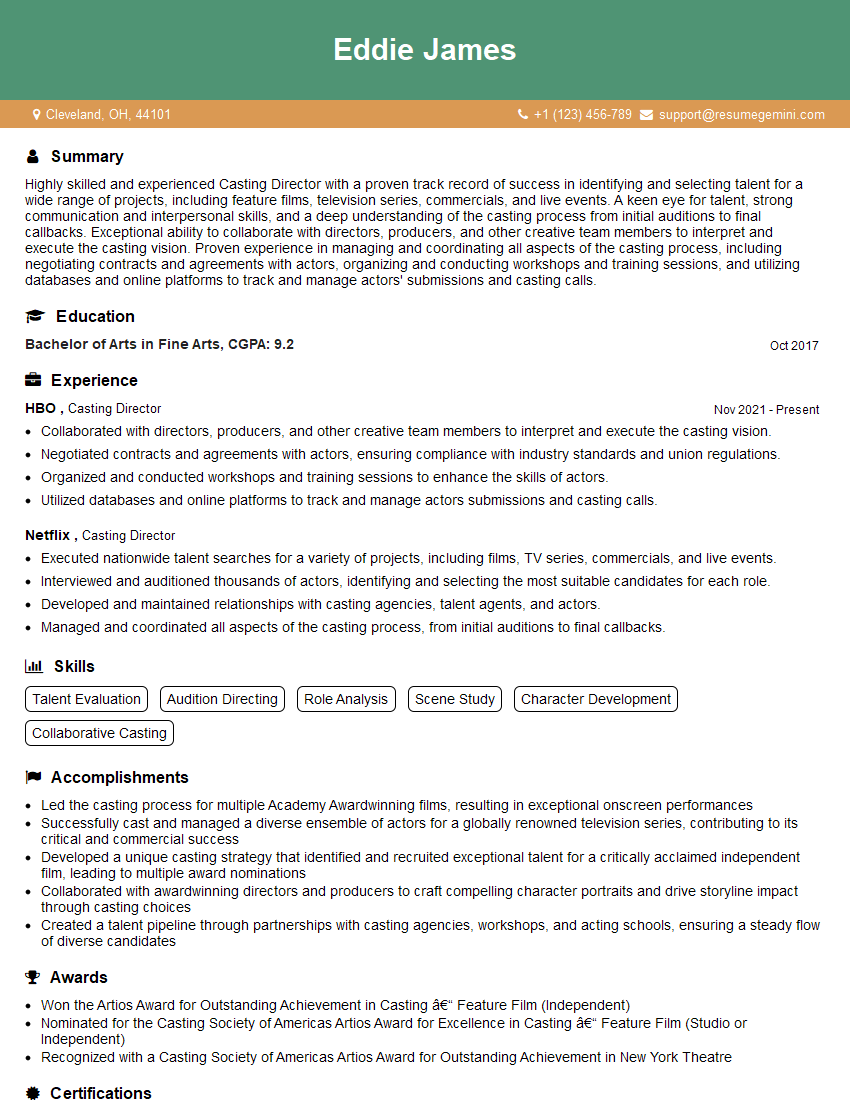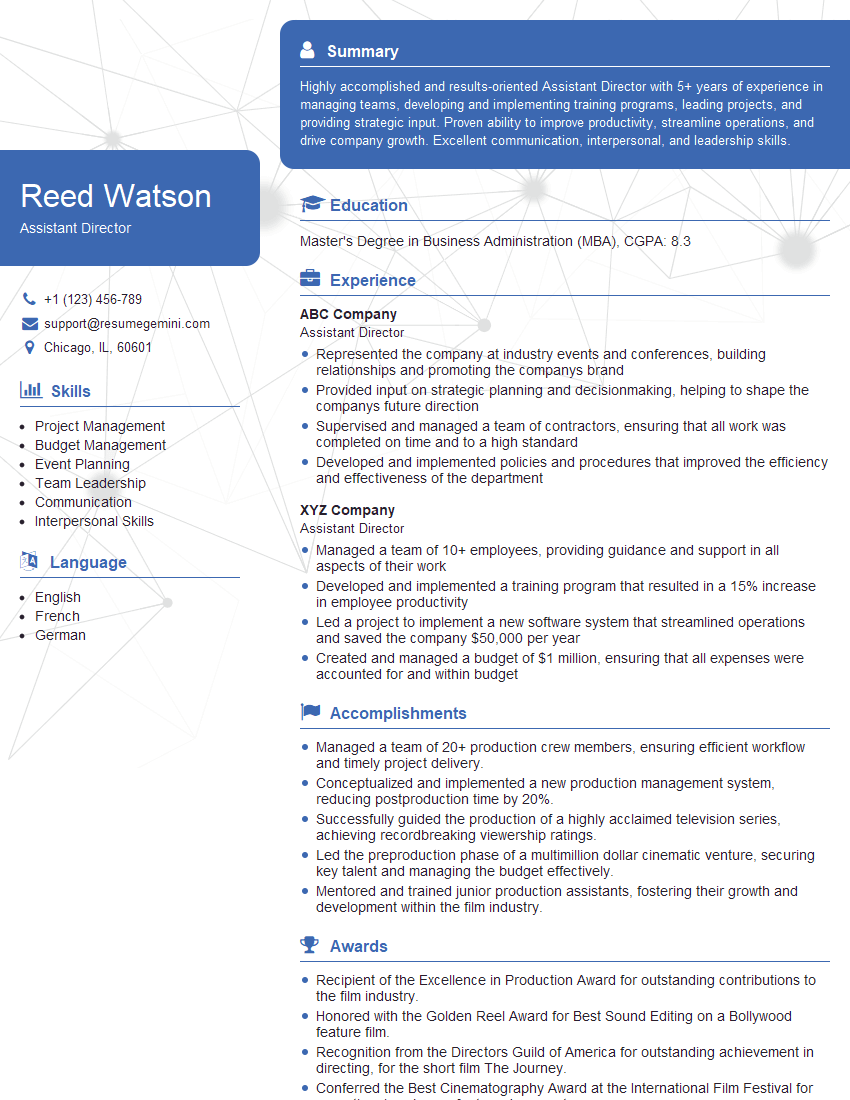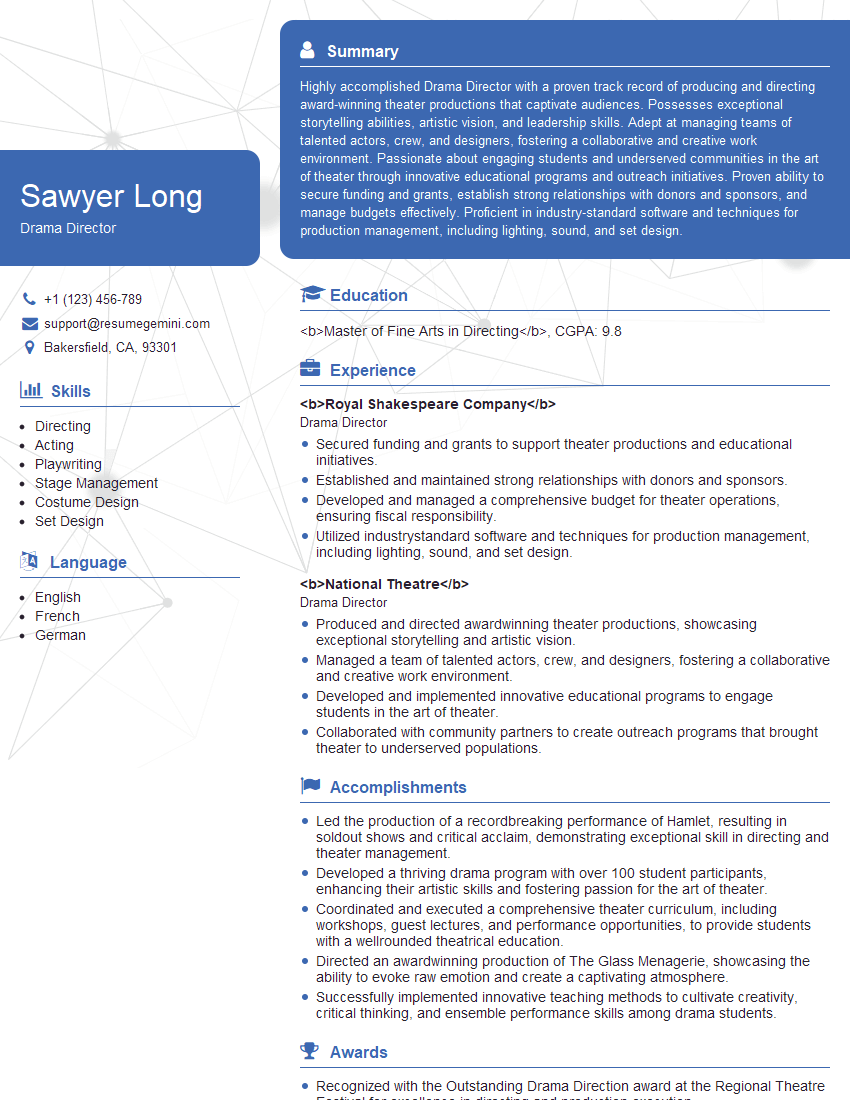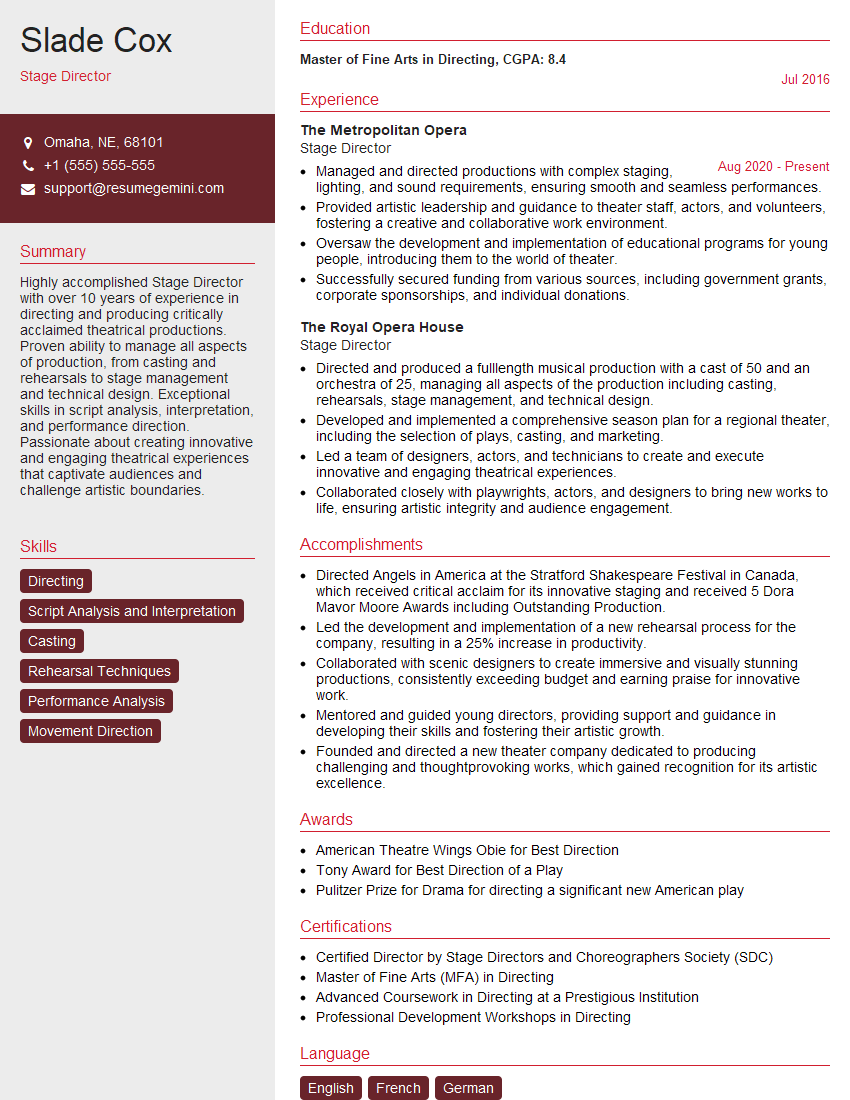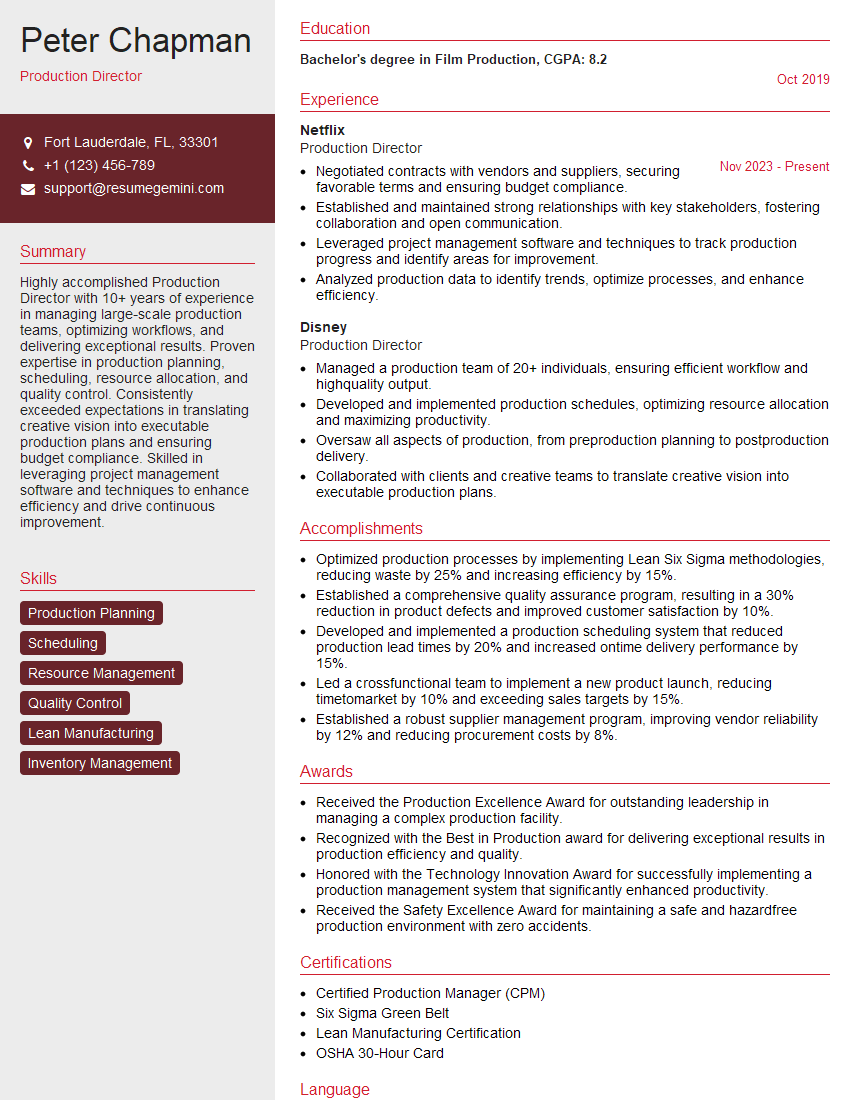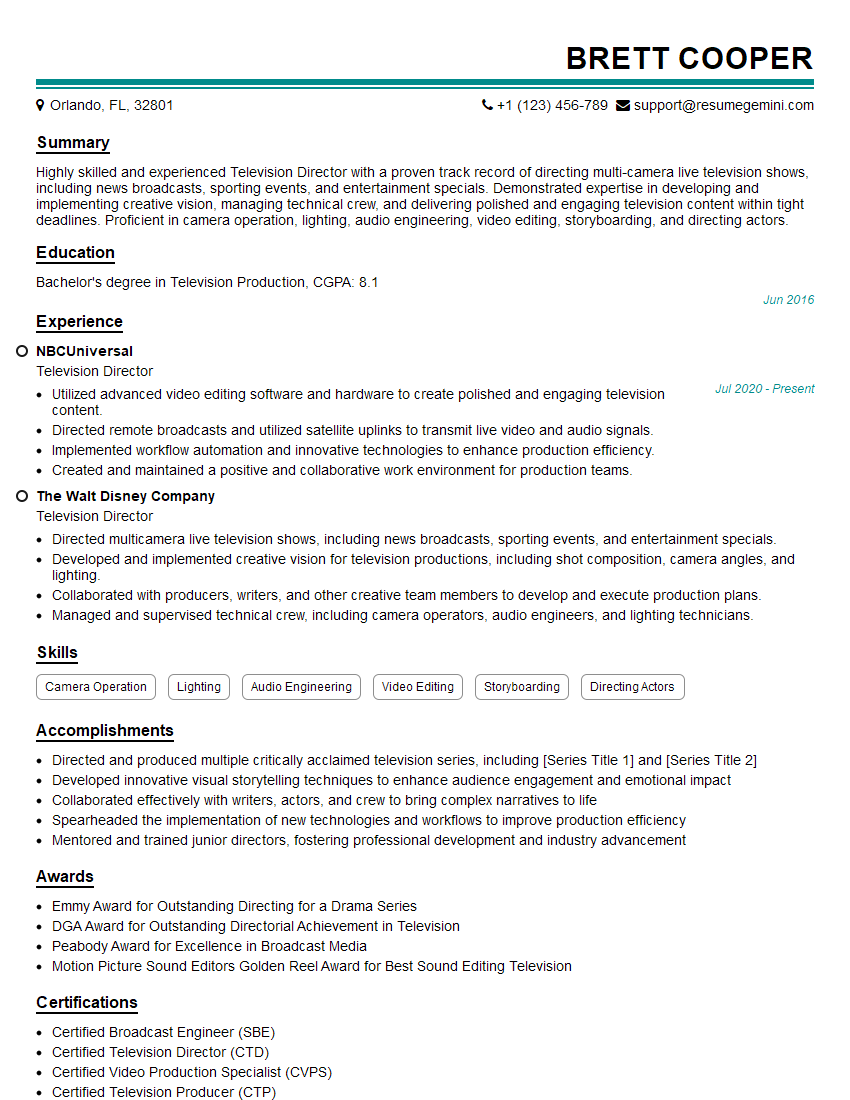Every successful interview starts with knowing what to expect. In this blog, we’ll take you through the top Directing Actors interview questions, breaking them down with expert tips to help you deliver impactful answers. Step into your next interview fully prepared and ready to succeed.
Questions Asked in Directing Actors Interview
Q 1. Describe your approach to blocking a scene for optimal visual storytelling.
Blocking a scene is like choreographing a dance for the camera. My approach prioritizes visual storytelling by considering the camera angles, actor movement, and the emotional arc of the scene. I start with a general idea of the scene’s flow, then work with the actors to discover the most compelling physical relationships and movement patterns.
- Camera Angles: I consider where the camera will be positioned to best capture the actors’ emotions and the scene’s action. For example, a close-up can emphasize intimacy, while a wide shot can showcase the environment and character relationships.
- Actor Positioning: I pay close attention to the actors’ proximity to each other and to the set. Positioning can subtly convey power dynamics, emotional distance, or shared intimacy. Consider the difference between two actors facing each other directly versus standing at an angle – the subtle shift dramatically impacts the scene’s subtext.
- Movement and Rhythm: I guide actors to move with purpose, avoiding unnecessary or distracting movements. The pace and rhythm of the actors’ movements should reflect the emotional tempo of the scene. A tense scene might feature slower, more deliberate movements, while a playful scene could have faster, more energetic movement.
- Rehearsals and Experimentation: I encourage experimentation during rehearsals. We might try different blocking options, exploring how the arrangement affects the scene’s visual impact and emotional resonance.
For instance, in a scene depicting a heated argument, I might position the actors close together, their bodies tense, reflecting the conflict. As the argument intensifies, I might have one actor step back, creating a visual representation of their emotional distance.
Q 2. How do you handle an actor who is struggling with a specific scene?
When an actor is struggling, patience and empathy are key. I start by understanding the root of the problem. Is it the script, the character, a technical issue, or something personal affecting their performance?
- Open Communication: I create a safe space for the actor to share their concerns without judgment. It’s crucial to listen actively and understand their perspective.
- Identifying the Issue: Once I understand the source of their struggle, I can work collaboratively to find solutions. Sometimes it’s a simple matter of clarifying the character’s motivation or adjusting the blocking. Other times, we might need to explore the actor’s personal experiences to find an emotional connection to the role.
- Breaking Down the Scene: If the scene is overwhelming, we break it down into smaller, manageable units. This can make the task less daunting and allow the actor to focus on specific elements.
- Providing Encouragement and Support: Throughout the process, I offer encouragement and remind the actor of their strengths and talents. Positive reinforcement builds confidence and allows them to approach the scene with renewed enthusiasm.
- Experimentation and Flexibility: I always keep my approach flexible. If one method isn’t working, I try another approach, until we discover the strategy that unlocks the actor’s best performance.
For example, if an actor is struggling to portray grief, instead of directly instructing them to “cry,” I might explore techniques like recalling a personal loss, listening to evocative music, or improvising related dialogues to tap into their authentic emotions.
Q 3. Explain your method for providing constructive criticism to actors.
Constructive criticism is about guiding actors towards a stronger performance, not about tearing down their work. I always aim for specificity, focusing on observable behaviors rather than making vague judgments.
- The “Sandwich” Method: I typically frame my criticism using the “sandwich” method: I start with a positive comment, then offer specific feedback for improvement, and end with another positive comment. This approach makes the feedback more palatable and avoids demoralizing the actor.
- Focus on Specific Actions: Instead of saying “your performance was weak,” I might say, “I noticed your delivery of this line felt rushed; perhaps slowing down slightly would allow for more emotional impact.”
- Collaboration and Suggestion: I always present my feedback as suggestions rather than demands, inviting the actor to participate in shaping the character’s development.
- Observe and Understand: Before offering feedback, I make sure I thoroughly understand the actor’s choices and intentions.
- Provide Clear Examples: I might use specific examples from the rehearsal or previous takes to illustrate the areas needing improvement.
The goal is not to impose my vision but to help the actor refine their performance in a way that feels authentic and impactful.
Q 4. What techniques do you use to elicit authentic emotions from actors?
Eliciting authentic emotions requires creating a safe and trusting environment where actors feel comfortable expressing themselves. There’s no magic formula, but several techniques are highly effective.
- Understanding the Character’s Backstory and Motivation: I work closely with actors to develop a deep understanding of their character’s background, desires, and motivations. The more an actor understands their character, the easier it becomes to embody their emotions.
- Improvisation and Exploration: Improvisational exercises can help actors discover unexpected emotional connections to their characters and the story.
- Sensory Work: Encouraging actors to utilize their senses —sight, sound, smell, taste, and touch— can help them access memories and experiences that evoke genuine emotions.
- Personal Connection: I encourage actors to draw upon their own experiences, but it’s crucial to establish healthy boundaries and avoid overly intrusive questioning.
- Subtext and Nuance: Focusing on the character’s subtext and unspoken emotions often yields more authentic results than overtly emotional displays.
For example, I might ask an actor to recall a specific memory related to loss or betrayal and then channel those feelings into their performance. The key is creating a collaborative environment that inspires honesty and trust.
Q 5. How do you collaborate effectively with other members of the production team?
Collaboration is paramount in filmmaking. I work closely with the cinematographer, production designer, and other department heads to ensure that every element supports the storytelling.
- Open Communication: I maintain open and consistent communication with all team members, sharing my vision and actively soliciting their input.
- Shared Goals: I make sure everyone understands our shared goals for the scene and the film as a whole. This creates a cohesive team effort.
- Respect and Appreciation: I treat everyone on the set with respect and appreciation, valuing their expertise and contributions.
- Problem-solving Collaboratively: When challenges arise, I work collaboratively with the team to find creative solutions.
- Pre-Production Planning: Extensive pre-production meetings with the various departments help to align everyone’s vision and avoid conflicts during production.
For example, I might discuss camera angles with the cinematographer to ensure that the blocking enhances the visual impact of the scene, or work with the production designer to create a set that reflects the emotional tone of the narrative. Open dialogue and mutual respect are the cornerstones of successful collaboration.
Q 6. Describe your experience working with actors from diverse backgrounds and experiences.
Working with actors from diverse backgrounds enriches the filmmaking process immensely. My approach emphasizes inclusivity and respect for individual experiences.
- Understanding Cultural Nuances: I always take the time to understand the actors’ cultural backgrounds and how those experiences might inform their interpretations of the roles.
- Creating a Safe and Inclusive Environment: Creating a safe, respectful environment where all actors feel valued and respected is crucial.
- Collaboration and Dialogue: I encourage open dialogue with actors about their perspectives and experiences, using their insights to inform my direction.
- Avoiding Stereotypes: I consciously avoid falling into stereotypes and encourage actors to bring their unique perspectives to their roles.
- Respectful Communication: I adapt my communication style to be respectful of cultural differences.
For example, when working with an actor from a different cultural background, I might seek input on how to accurately portray certain gestures, customs, or cultural nuances to avoid misrepresentation.
Q 7. How do you manage conflicting creative visions between actors and the production team?
Conflicting creative visions are inevitable in filmmaking. My approach is to facilitate dialogue and find common ground that serves the story’s overall objectives.
- Active Listening: I begin by actively listening to all parties involved, understanding their perspectives and the reasons behind their creative choices.
- Mediation and Facilitation: I act as a mediator, guiding the discussion towards finding mutually acceptable compromises.
- Focusing on the Story’s Goals: I remind everyone involved of the overarching goals of the story and how different perspectives can contribute to achieving those goals.
- Finding Common Ground: I encourage the actors and the production team to identify areas of agreement and build on those shared understandings.
- Compromise and Collaboration: The process often involves compromise. The goal isn’t to force a particular vision but to find a collaborative solution that benefits the film.
Ultimately, it’s about prioritizing the integrity of the story. Sometimes, a slight adjustment in one area can open up new possibilities that satisfy everyone’s creative needs.
Q 8. How do you adapt your directing style to different genres (e.g., comedy, drama, action)?
My directing style adapts to the genre’s inherent emotional tone and pacing. Comedy requires a lighter touch, focusing on precise timing, physicality, and playful improvisation. I encourage actors to explore the comedic potential of the text, using techniques like exaggeration and character-specific quirks. For example, in a recent comedy, I used improv games to help actors discover unexpected comedic beats within their characters’ interactions.
Drama, conversely, necessitates a more nuanced and introspective approach. The focus shifts to deeper emotional exploration, subtext, and believable character arcs. I might utilize sensory exercises or emotional recall techniques to help actors access the emotional depth of their roles. A particularly moving scene in a recent drama involved guiding the lead actor through a guided visualization exercise to tap into the character’s past trauma.
Action scenes demand meticulous planning and precise choreography. Safety is paramount, and clear communication with the stunt team and actors is crucial. I work closely with actors to ensure they understand the physical demands and execute the choreography safely and effectively. In one action sequence, I utilized storyboarding and detailed rehearsals to create a fluid, believable fight sequence while maintaining a safe environment for the actors.
Q 9. What is your process for casting actors?
Casting is a vital part of the filmmaking process. I begin by thoroughly analyzing the script, creating detailed character breakdowns that go beyond just the surface level. I look for actors not just who fit the role physically, but who possess the emotional range and interpretive skills to bring the character to life. I then review headshots, reels, and audition tapes to assess their performance skills and ability to embody different roles.
Auditions are crucial. I often design specific scenes or exercises to test their ability to work within the parameters of the given script, while also leaving room for improvisation. I observe their interactions with other actors and their ability to take direction. This approach ensures that the chosen actors are both talented and a good fit for the overall project dynamic. Finally, chemistry readings between potential cast members are invaluable in ensuring the ensemble works seamlessly together.
Q 10. How do you maintain a positive and productive atmosphere on set or in rehearsal?
Maintaining a positive and productive atmosphere hinges on fostering open communication, mutual respect, and a shared creative vision. I encourage actors to express their ideas and concerns without fear of judgment. I start by having regular team meetings to discuss the project’s vision and expectations, and I hold individual meetings with each actor to discuss their character’s arc and motivations. Building a strong sense of community amongst the cast and crew is essential; it creates a supportive environment where actors feel safe to take risks and explore their characters fully. Regular breaks, casual social activities, and clear and consistent communication all contribute to a healthy working environment.
For example, on a particularly challenging shoot, I introduced a daily ‘gratitude circle’ where everyone shared something they were thankful for. This simple exercise created a sense of shared experience and boosted team morale significantly. I also emphasize the importance of work-life balance, encouraging actors to prioritize their wellbeing both on and off set.
Q 11. How do you handle on-set challenges, such as unexpected delays or technical difficulties?
Unexpected delays and technical difficulties are inevitable on set. My approach is proactive and problem-solving oriented. I have a contingency plan for various scenarios, including backup equipment and alternative shooting locations. Open communication with the crew is crucial; keeping everyone informed about the situation and its impact helps maintain morale and find solutions collaboratively.
When faced with unforeseen challenges, I focus on adapting the plan rather than fighting against the situation. This might involve rescheduling scenes, finding creative workarounds, or simplifying complex shots. Flexibility and a willingness to adjust the schedule are key to maintaining progress and keeping the actors engaged and focused. In one instance, a sudden power outage forced us to rethink the lighting design entirely. We quickly adjusted to utilize natural light, resulting in a surprisingly beautiful and unique aesthetic.
Q 12. What strategies do you employ to ensure actor safety and well-being during production?
Actor safety and wellbeing are paramount. This begins with pre-production safety briefings, covering potential hazards and safety protocols specific to the project. For action sequences, I work closely with stunt coordinators and ensure actors receive appropriate training and safety equipment. I am vigilant about working conditions, ensuring actors are adequately rested, hydrated, and have access to medical support if needed.
Open communication is key to understanding the actor’s physical and emotional needs. I encourage actors to voice any concerns or discomfort without hesitation. I maintain a safe space for them to share feedback without judgment. For example, during intense emotional scenes, I incorporate breaks to provide actors with time to decompress and reset. I also work with a mental health professional, providing actors with access to counseling if needed. Prioritizing actors’ well-being results in higher quality performances and strengthens the overall team dynamic.
Q 13. Describe your experience with different rehearsal techniques (e.g., table reads, improv exercises).
I utilize a variety of rehearsal techniques, tailoring my approach to the specific needs of the project and the actors involved. Table reads are invaluable for getting a feel for the rhythm and pacing of the script, allowing actors to understand their character’s relationships with others. Improv exercises can be incredibly helpful for developing character nuances and exploring unexpected comedic or dramatic possibilities. These exercises help actors relax, build trust, and foster creative collaboration.
I also incorporate physical rehearsals, especially for scenes involving movement or physical interaction. This allows actors to become comfortable with the staging and blocking before filming begins, which streamlines the shooting process. I often combine these techniques, using table reads to establish a foundational understanding of the text, followed by improv exercises to allow for creative exploration and physical rehearsals to ensure seamless movement within the scene.
Q 14. How do you incorporate actor input and feedback into the creative process?
Actor input is invaluable. I create an environment where actors feel comfortable sharing their interpretations, suggestions, and concerns. I actively listen to their feedback and incorporate their ideas whenever possible, especially if they improve the overall storytelling or character development. This collaborative approach fosters trust and strengthens the creative process. Sometimes, an actor’s insight brings unexpected depth or complexity to a scene that I wouldn’t have considered.
For example, one actor suggested a subtle shift in their character’s posture to convey a hidden vulnerability, a detail which had a profound impact on the overall emotional impact of a key scene. I believe that the best performances emerge when there’s a strong collaborative relationship between the director and the actors; it’s about creating a shared artistic vision.
Q 15. What is your approach to working with actors on improvisation and spontaneity?
My approach to improvisation and spontaneity with actors hinges on building a foundation of trust and collaborative exploration. It’s not about chaotic free-for-alls, but rather about creating a safe space where actors feel empowered to take risks. I start by ensuring the actors thoroughly understand the scene’s context, character objectives, and overall story arc. Then, I encourage them to experiment within the established parameters.
For instance, if we’re working on a scene depicting a tense confrontation, I might suggest specific starting points – a certain gesture, a line of dialogue – and then let the actors organically build from there. I might say, “Try starting with a seemingly casual gesture, then let the tension escalate naturally through your actions and reactions.” I actively listen, observing where the improvisation takes us, and offer subtle guidance or suggestions when necessary. The key is to steer, not control, helping actors discover unexpected yet character-appropriate moments.
I often use games and exercises designed to boost spontaneity, like “Yes, and…” This technique trains actors to build on each other’s contributions rather than block them. I might also incorporate character-specific improvisational exercises to deepen their understanding of their character’s traits and reactions. The result is often richer, more believable performances.
Career Expert Tips:
- Ace those interviews! Prepare effectively by reviewing the Top 50 Most Common Interview Questions on ResumeGemini.
- Navigate your job search with confidence! Explore a wide range of Career Tips on ResumeGemini. Learn about common challenges and recommendations to overcome them.
- Craft the perfect resume! Master the Art of Resume Writing with ResumeGemini’s guide. Showcase your unique qualifications and achievements effectively.
- Don’t miss out on holiday savings! Build your dream resume with ResumeGemini’s ATS optimized templates.
Q 16. How do you utilize different directing styles to suit an actor’s performance?
Directing styles are tools in my toolbox; I select them based on the actor, the role, and the project’s demands. For example, with a highly experienced actor comfortable with autonomy, I might adopt a more collaborative, hands-off approach, primarily providing feedback and guidance. I value their expertise and allow them space for creative exploration.
Conversely, with a newer actor or one who needs more direction, I might employ a more structured, prescriptive approach. This involves detailed discussions about character motivations, clear blocking instructions, and specific line readings.
Let’s consider a scene requiring a delicate emotional performance. With a sensitive actor, I’d opt for a supportive and empathetic style, encouraging vulnerability and providing reassurance. In contrast, if I need a strong, commanding performance, a more assertive style might be more effective. I adjust my communication, offering constructive criticism with tact and sensitivity, always remembering the overall goal is to help them achieve their best performance.
Q 17. How do you help actors achieve a consistent level of performance across multiple takes?
Maintaining consistent performance across multiple takes requires clear communication and a collaborative approach. Before each take, I reiterate the scene’s objectives, the character’s emotional state, and any specific notes from the previous takes. I create a relaxed and focused atmosphere on set to help actors stay in the zone.
I avoid interrupting takes unless absolutely necessary, allowing actors the freedom to explore the scene organically. After each take, I provide specific feedback, focusing on what worked well and offering constructive criticism for areas needing improvement.
For example, if an actor’s emotional delivery varies across takes, I might ask, “Can we explore that moment of hesitation a little more subtly in the next take?” Or, “Let’s try emphasizing the underlying vulnerability in your voice this time.” I strive to be specific and encouraging, ensuring that the actor understands how each adjustment can enhance the performance.
Q 18. Describe your experience with directing actors in different mediums (e.g., stage, film, television).
My experience spans stage, film, and television, each medium presenting unique challenges and opportunities. On stage, the focus is on larger-than-life performances and audience engagement. The collaborative relationship with the actors is more sustained, allowing for deeper exploration during rehearsals.
Film requires more precision and control. We might shoot multiple takes from different angles, each necessitating a consistent performance. Here, the actor’s ability to maintain emotional consistency and nuanced physicality is crucial. Television directing often involves quicker turnaround times and a greater focus on technical efficiency while still retaining the performance quality. In all mediums, the essence is to build a rapport with the actors, understanding their individual processes and strengths to craft compelling performances.
For example, a monologue that works wonderfully on stage might need to be broken down and re-shot in several pieces for a film. This requires precise direction and a keen understanding of how the actor can maintain focus and deliver the same emotional impact across individual shots.
Q 19. How do you ensure the actor understands the character’s motivation and objectives?
Ensuring actors understand character motivation and objectives is paramount. I achieve this through extensive pre-production discussions, character analyses, and collaborative scene work. I encourage actors to delve deep into the script, exploring the character’s backstory, relationships, and hidden desires.
I often utilize techniques like creating detailed character biographies, exploring “what if” scenarios, and engaging in improvisation exercises centered around the character’s motivations. For instance, we might explore a scene from the character’s perspective, asking, “What’s their ultimate goal in this interaction? What are the stakes? What are they afraid of losing?”
I also use visual aids like mind maps or storyboards to help actors visualize the character’s journey and their place within the broader narrative. The process is iterative; we refine the understanding of the character’s motivations through discussion and rehearsal, ensuring the performance authentically reflects their inner world.
Q 20. How do you work with actors to develop a believable character arc?
Developing a believable character arc involves a collaborative process between the actor and director. We begin by mapping out the character’s trajectory from the beginning to the end of the story, identifying key turning points and significant changes.
I work closely with the actor to identify moments where the character experiences significant shifts in their outlook or behavior. We discuss the catalyst for these changes and how they manifest in the character’s actions and dialogue. This might involve examining specific scenes, exploring different emotional states, and experimenting with physicality.
For instance, a character initially driven by revenge might undergo a transformation through compassion, forgiveness, or self-discovery. We’d discuss how this inner change is reflected in the character’s physicality, voice modulation, and overall demeanor. It’s about crafting a gradual and believable transformation, rather than an abrupt shift. The arc should feel organic and consistent with the character’s personality and motivations.
Q 21. Explain your approach to working with actors on physicality and movement.
Physicality and movement are integral aspects of character development and storytelling. My approach involves a combination of careful observation, collaborative exploration, and targeted exercises. I begin by discussing the character’s physical attributes, posture, gait, and mannerisms. We explore how these aspects reflect the character’s personality, social standing, emotional state, and overall backstory.
I might use movement exercises to help actors embody the character. This could include improvisational movement sequences, physical explorations of specific emotional states, or working with a movement coach to refine specific gestures or postures.
For example, a character who is perpetually anxious might exhibit nervous fidgeting, while a powerful character might possess a commanding posture and deliberate movements. The goal is to ensure that the actor’s physicality enhances the storytelling and seamlessly integrates with the character’s inner world. I strive for authenticity, making sure the physicality feels natural and believable, enhancing rather than distracting from the performance.
Q 22. How do you guide actors through complex emotional scenes while maintaining their well-being?
Guiding actors through complex emotional scenes requires a delicate balance of empathy, technical skill, and respect for their well-being. It’s not just about eliciting the right emotion; it’s about creating a safe space for them to explore it authentically.
My approach begins with thorough pre-production. I work closely with the actors to understand the character’s backstory, motivations, and relationships. We discuss potential emotional triggers and explore different approaches to portraying the scene. During rehearsals, I create a supportive environment where actors feel comfortable taking risks and experimenting. I might use techniques like emotional recall (carefully and ethically, of course), sensory exercises, or even physical movement to help them access the required emotions.
Crucially, I emphasize clear communication. I listen actively to the actors’ concerns and provide reassurance and support. If they’re struggling, I adjust the pace, break down the scene into smaller chunks, and offer alternative approaches. I always prioritize their comfort and mental health, and I make sure they have the support of the production team, including a wellness professional if necessary.
For instance, in a scene depicting grief, I might start by having the actor focus on a specific physical sensation associated with their character’s loss – a tightness in the chest, a trembling hand. Then, we’d gradually build towards more intense emotional expression, pausing frequently to check in and ensure they’re not overwhelmed.
Q 23. What is your process for providing feedback on actor’s performance?
Providing feedback is as much an art as it is a science. It’s about offering constructive criticism that helps actors improve their performance without demoralizing them. My approach is always specific, actionable, and positive. I avoid vague statements like “that was good” and instead focus on concrete observations.
I typically structure my feedback around three key areas: objective observation (what I actually saw), subjective interpretation (my understanding of their choices), and suggested adjustments (concrete improvements). For example, I might say: “In the scene where you confront your brother, I noticed your posture was quite rigid (objective observation). This suggested to me a sense of suppressed anger, rather than the open conflict I was aiming for (subjective interpretation). Perhaps if you tried loosening your shoulders and using more expansive gestures, it could convey that conflict more clearly (suggested adjustment).”
I also value collaboration. After providing my feedback, I create space for dialogue. I ask the actors about their own interpretations and choices, encouraging them to share their thoughts and feelings. This collaborative approach allows for a mutual understanding and ensures the feedback is truly helpful and meaningful.
Q 24. How do you adjust your approach based on the experience level of the actors?
My approach to directing actors varies significantly depending on their experience level. With experienced actors, I can often offer more nuanced direction, trusting their intuition and allowing for more improvisation. The focus becomes collaboration and refining their existing skills. We might delve into complex character analysis or explore subtle variations in delivery.
With less experienced actors, my approach is more instructional. I provide clearer, more structured guidance, focusing on fundamental techniques such as line delivery, physicality, and emotional expression. I’ll often break down scenes into smaller units, focusing on mastering individual elements before integrating them into the whole. I’ll also be more patient and supportive, offering positive reinforcement and encouragement. I might use visual aids or examples from other films to illustrate my points.
Ultimately, my goal is to help each actor reach their full potential, regardless of their experience. I tailor my approach to their individual needs and learning styles, fostering a safe and supportive environment where they can learn and grow.
Q 25. Describe a time when an actor’s performance significantly exceeded your expectations. What did you do?
During the filming of a small independent film, a relatively unknown actor, playing a distraught mother, delivered a scene of unimaginable power. The script called for a quiet, heartbreaking moment, but she brought a raw intensity and a depth of emotion that far exceeded my expectations. Tears streamed down her face, but it wasn’t just acting; you felt the genuine weight of her character’s loss.
My response wasn’t to change anything. Her performance was authentic, breathtaking, and perfectly suited to the scene’s needs. I simply ensured we captured it from various angles to showcase her talent effectively. I gave her minimal direction, mostly praising her bravery and honesty. Later, I debriefed with her to understand what allowed her to reach that level of emotional depth, learning from her process. It was a testament to the power of trust, collaboration, and giving an actor space to shine.
Q 26. Describe a time when an actor’s performance fell short. How did you address it?
In another project, an actor struggled to portray a character’s underlying cynicism. The script indicated this cynicism through subtle gestures and sarcastic remarks, but the actor delivered the lines with a flat affect. The scene felt lifeless.
My first step was to have a private conversation with the actor, understanding that the difficulty could stem from various reasons including misinterpretation of the character, a lack of confidence, or even personal anxieties affecting their performance. We discussed the character’s motivations and backstory, revisiting the script’s subtext. We also explored different techniques for conveying sarcasm – through vocal inflection, facial expressions, or even body language.
We worked on the scene in increments, focusing on small adjustments. We rehearsed a single line repeatedly, experimenting with different inflections, until we found one that successfully conveyed the intended cynicism. We then built on that success, expanding to the entire scene. The actor gradually gained confidence, and the final performance was compelling. This situation highlighted the importance of patience, empathy and a collaborative approach when working with struggling actors.
Q 27. How do you ensure continuity and consistency in an actor’s performance across scenes?
Maintaining continuity and consistency in an actor’s performance across multiple scenes demands careful planning and communication. Before filming even begins, I collaborate with the actor and the team to establish a clear understanding of the character’s arc and emotional journey. We create a detailed character bible outlining their personality traits, motivations, and relationships.
During filming, I use various techniques to ensure consistency. We review dailies together, discussing performance choices and making necessary adjustments. I might use specific reference points from earlier scenes to guide the actor’s choices in subsequent scenes. The continuity script supervisor is crucial here, tracking key details like wardrobe and props to ensure visual consistency.
Another useful tool is using a detailed shot list. This allows both me and the actor to maintain awareness of the narrative progression, and how each scene contributes to the overall character arc. Finally, maintaining clear communication and offering regular check-ins, and creating a relaxed atmosphere allows the actor to feel confident and to maintain their character throughout the shoot.
Q 28. What are some common mistakes that directors make when working with actors?
One common mistake directors make is providing vague or unhelpful feedback to actors. Instead of offering concrete, actionable suggestions, they may simply say, “Try again,” or “Be more emotional.” This lacks direction and can leave actors feeling confused and demoralized.
Another mistake is micromanaging actors. While providing guidance is essential, directors should avoid controlling every aspect of an actor’s performance. This stifles creativity and can lead to unnatural or forced performances. Directors should learn to trust actors’ instincts and allow them space for interpretation and improvisation.
Finally, some directors fail to establish a positive and supportive working relationship with their actors. A tense or negative atmosphere can negatively impact performances. Creating a safe space where actors feel comfortable taking risks and expressing their creativity is crucial for success.
Key Topics to Learn for Directing Actors Interview
- Understanding Actor Psychology: Explore techniques for building rapport, understanding actor motivations, and fostering trust on set. Practical application: Discuss strategies for effectively communicating your vision to actors with diverse backgrounds and experiences.
- Scene Analysis & Interpretation: Mastering the art of breaking down a script and translating its meaning into compelling visual storytelling. Practical application: Describe your process for collaborative interpretation of a scene with actors, ensuring a shared understanding of character arcs and thematic elements.
- Directing Techniques: Explore various directing styles (e.g., collaborative, autocratic) and their application based on the project and actors. Practical application: Provide examples of how you adapt your approach to different actors and project demands.
- Collaboration and Communication: Effective communication with actors, crew, and producers is crucial. Practical application: Discuss how you manage conflict resolution and maintain a positive and productive work environment on set.
- Casting and Rehearsals: The process of selecting actors who fit the roles and leading effective rehearsals. Practical application: Explain your strategies for preparing actors for performances, including rehearsal techniques and feedback methods.
- On-Set Management: Maintaining efficiency and productivity during filming, problem-solving, and addressing unexpected challenges. Practical application: Describe your experience in managing time constraints and unexpected issues on set while maintaining the artistic integrity of the project.
- Feedback and Actor Development: Providing constructive criticism and guidance to actors to help them deliver optimal performances. Practical application: Describe your approach to providing feedback – balancing encouragement with actionable suggestions.
Next Steps
Mastering the art of directing actors significantly enhances your career prospects, opening doors to exciting opportunities in film, television, and theatre. To maximize your chances of landing your dream role, it’s crucial to have a strong, ATS-friendly resume that showcases your skills and experience effectively. We highly recommend using ResumeGemini to build a professional and impactful resume tailored to the specific demands of Directing Actors roles. ResumeGemini provides tools and examples to help you craft a resume that stands out, increasing your visibility to potential employers. Examples of resumes tailored to Directing Actors are available for your review.
Explore more articles
Users Rating of Our Blogs
Share Your Experience
We value your feedback! Please rate our content and share your thoughts (optional).
What Readers Say About Our Blog
good

